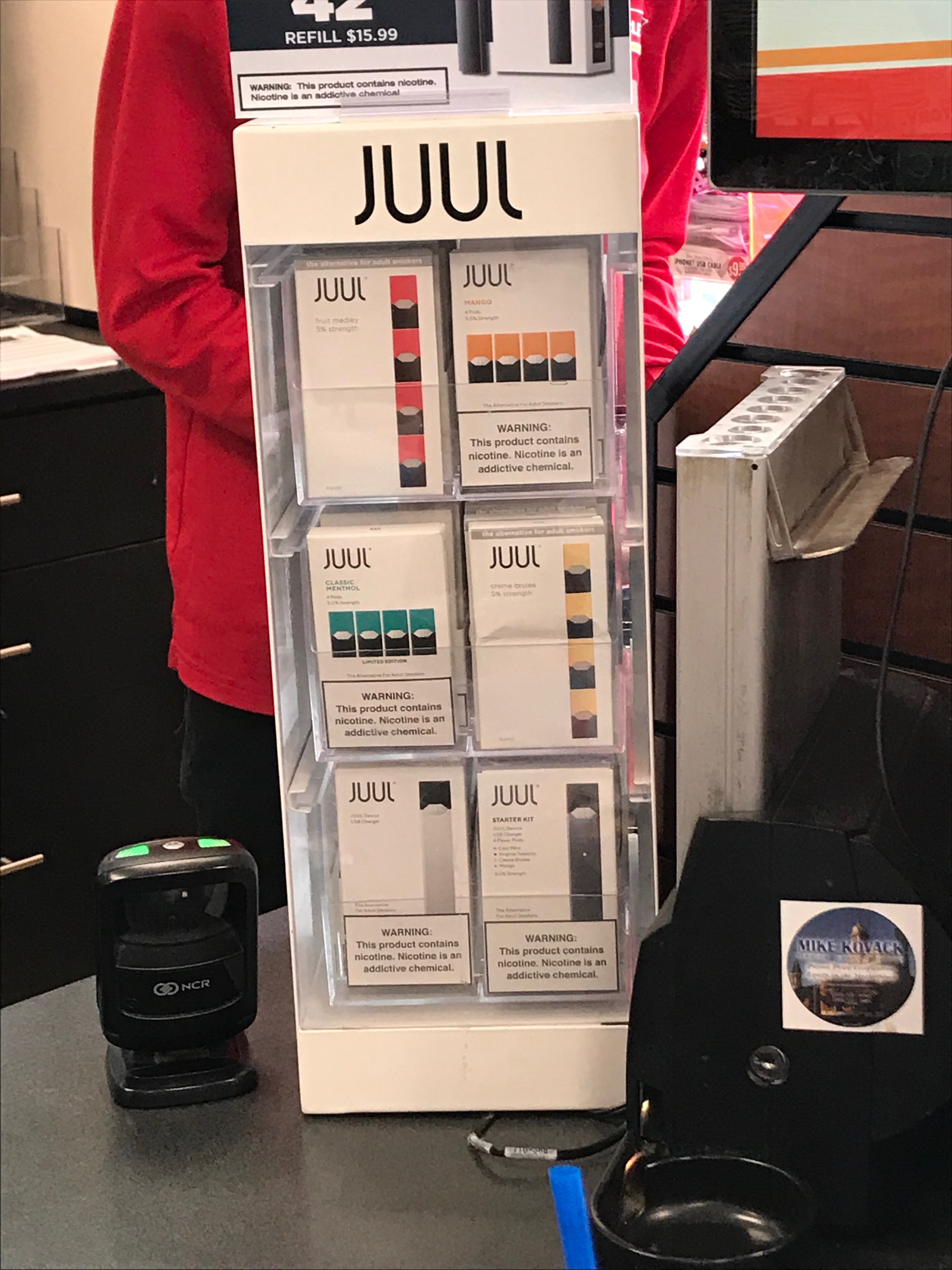BY JILLIAN CORNACCHIONE
With every new school year, administrators face new problems that change discipline standards and culture within the school.
One of these problems is the result of a new trend that is spreading to millions of teenagers living in the United States. This trend, known as juuling, has had enormous effects on many schools located throughout the nation. Administrators around the U.S. are wondering just how far students are willing to go to take their precious Juuls on school grounds.
The Juul was originally invented as an alternative for smokers interested in finding ways to quit or migrate from the classic, combustible cigarette. Nonetheless, the electronic cigarette backfired, having a different effect of what it was intended to do.
The device went on sale in June of 2015 and since then, people everywhere, especially teens, have joined the new craze, making juuling one of the biggest trends of this generation.
“I have noticed a lot of juuling around school in a certain number of my classes,” said Naty Kaser, 12. “Kids also do it in the bathrooms, at lunch, at their lockers and while walking in the hallways. Most of the students I see are under age.”
Schools continue to discipline juuling without knowing how to take the next step. The Juul is small enough to fit in the palm of a hand, concealing it from teachers and other adults. The discreet design makes it easy for students to pass them off as flash drives. But unlike a flash drive that stores computer files, this certain device stores nicotine.
To avoid confrontation while juuling in school, students will often either exhale the smoke into their shirts, wait until the teacher turns their back or simply not exhale the smoke at all.

Students can take a Juul just about anywhere unnoticed. Classrooms, hallways, restrooms and school sporting events are all common areas to pull out the battery-powered device.
There are national regulations placed on Juuls to help control the problems they are causing in schools. For instance, Juuls, as well as all e-cigarettes, are illegal for minors. You must be 18 years of age or older here in Wadsworth to purchase a Juul or any Juul accessory. Fourteen cities in Ohio, and many others nationally, have even raised the age of purchase to 21. However, these limitations do not seem to stop underaged kids from getting their hands on these devices.
Some teens that are not of legal age to purchase or use the devices still brag about juuling both in person and on social media, sparking concern about e-cigarette use among young people.
Pushed by peer pressure and naiveté, the trend continues to rapidly grow. Schools have begun to really get involved, taking precautions to help cease the bad habit at school. Wadsworth High School has started to crack down on the juuling policy in order to keep a safe and healthy environment for the rest of the students.
“Right now we treat juuling as having cigarettes,” explained Principal Moore. “If someone is caught with a Juul on school property, we would give them in-school detention. We also take the devices from them and turn it back over to the parents. We have even made students go to a tobacco education class.”
Sometimes these punishments are not as effective as originally planned. Kids are still caught juuling on school property on a regular basis. Because of this, Mr. Moore shared that the school board and himself have had informal dialogue about possibly taking a harder stance on vapes and Juuls and treating them more like drugs, instead of cigarettes. He hopes that this change in discipline might help get the point across to students in a more effective way.
Some schools across the nation, most notably a high school in Maryland, have gone as far as removing restroom doors that could conceal juul gatherings and some have even started banning flash drives to avoid the cover up all together.
Despite these precautions being put into effect, efforts to reduce juuling have had minimal results. Administrators still find students juuling and vaping in the parking lot, in classrooms and other parts of school property.
Some administrators worry that this is only the beginning of the problem.
“I believe Juuls and vapes are just an avenue towards bigger and worse things to do, like when it comes to smoking and marijuana,” said Moore.
Because a Juul is high in nicotine, it becomes addictive. Nicotine can also offer a momentary feeling of calmness, which also can add to the popularity. Combine these risks with peer pressure, and juuling becomes another fashionable trend to have in high school.

While juuling has serious effects on those participating in the activity, there can be adverse effects to those in surrounding circles. Not only can the vapor exhaled by a juuler can be compared to secondhand smoke, juuling with or around others can lead to more peer pressure and influence to participate in the activity.
“Juuling is a horrible habit that many students have and a huge distraction to other students in their classes. It’s something that shouldn’t be exposed to teenagers and should be treated with harsh consequences,” said Kaser.
Juuls bring forth a significant number of consequences in schools nationwide and pose a great risk towards a safe educational system. Because of this, the near future holds a possible solution to this epidemic among teens. There are a number of laws being discussed about, that are likely to be put into effect in order to make sure that there are assured restrictions on the use of e-cigarettes.
According to a 2018 release from the Food and Drug Administration, the teen vaping trend has reached “epidemic proportions” and the agency plans to crack down on retailers who sell to teens. There has even been conversation about banning Juuls nationally all together.
Most laws have not yet been enacted, but many are looking toward a future that will no longer be going up in smoke or vape.





![Wadsworth's Class Of 2025 Walks At Graduation Ceremony [Photo Gallery]](https://wadsworthbruin.com/wp-content/uploads/2025/05/IMG_9018-1-1200x800.jpg)































